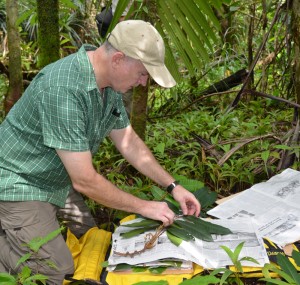A Silver Lining from Super Typhoon Haiyan
Posted in Travelogue on December 10, 2013 by Gregory Plunkett
Gregory M. Plunkett, Ph.D., is Director and Curator of the Cullman Program for Molecular Systematics at The New York Botanical Garden. Michael J. Balick, Ph.D., is the Vice President for Botanical Science and Director and Philecology Curator of the Botanical Garden’s Institute of Economic Botany.

A month ago, one of the deadliest typhoons in recorded history ripped through the western Pacific on a collision course with the Philippines, where it took the lives of nearly 6,000 people after it made landfall on November 8. On its way, Super Typhoon Haiyan battered the Pacific island nation of Palau, where we and two local researchers were studying the flora of this remote archipelago as part of The New York Botanical Garden’s long-term commitment to the botany of the region.
It’s hard to conceive of a bright side to the devastation and suffering left in the wake of Haiyan, but our team managed to put the storm’s enormous power to some good use. Our arrival in Palau (also known as Belau and comprising over 250 islands) preceded Haiyan’s by just three days. We were joined by Ann Kitalong and Van Ray Tadao, two researchers from the Belau National Museum, to document the flora of some of the country’s least known forest habitats on the main island of Babeldaob and to continue working on a book that will document Palau’s ethnobotany, the second in a series of volumes examining the relationship between plants and people in Micronesia.
For the first two days, the research team explored the island’s dense forests, but we then halted our work to take cover for the impending storm. The eye of the typhoon passed only seven miles from Kayangel, Palau’s northernmost island, destroying all of its homes and nearly every tree. Back on Babeldaob, 50 miles to the south, the hurricane-force winds forced us to abandon our top-story dwelling at 2 a.m. in fear of losing the roof and windows, hunkering down instead in a more secure ground-level, concrete shelter. We emerged the next morning to survey the damage to homes and habitats, thankful that no lives were lost anywhere in Palau. On the day after the storm, we returned to the collection sites where we had been working to find the forests littered with downed trees and branches.
Despite the devastation, the destructive forces of the storm had delivered a bonanza of botanical specimens from the canopy to the forest floor, allowing us to collect flowers and fruits from the limbs of otherwise inaccessible trees, as well as an abundance of orchids, ferns, and other epiphytes that make their homes in canopy branches far out of reach from where botanists usually tread. Plants that had been unseen and inaccessible just days before were now within easy reach. This scene was repeated for the next six days as our research team expanded our surveys to other sites on Babeldaob and nearby Koror, gathering 160 plants and generating nearly 1,000 herbarium specimens. Each plant was geo-referenced, photo-documented, and preserved for DNA-based studies, giving some small meaning to the shocking destruction and tragic losses caused by Haiyan.
Support for our trip to Palau was provided by the National Geographic Society and the Gildea Foundation.

